By developing such higher-performance steel products as high-strength steel sheets to reduce vehicle weight, the steel industry provides products that when used contribute to the conservation of energy in society.
The LCA Energy Assessment Committee* was organized in 2001 with the aim of examining how higher performance steel products have contributed, from an LCA (life cycle assessment) perspective, to energy savings throughout society as a whole.
As a result of the assessment and analyses made by the Committee, it is quantitatively clear that, in spite of greater CO2 emissions during their manufacture, higher-performance steel products offer two advantages that greatly curb overall CO2 emissions: they emit less CO2 at the application stage and they decrease the amount of steel needed.
The reduction in CO2 emissions made possible by steel products manufactured between 1990 and 2000 is estimated at about 9.64 million tons as of 2000 (3.14 million tons of CO2 during production and 6.50 million tons during application).
*Chairman: Prof. K. Yoshioka, Keio University
Committee members: Representatives from steel-using industries (Japan Federation of Construction Contractors, The Japan Society of Industry Machinery Manufacturers, Japan Automobile Manufacturers' Association, The Shipbuilders' Association of Japan, The Japan Electrical Manufacturers' Association), The Institute of Energy Economics, Japan, and others
Items 1 to 4 in the following figure are cited as energy savings attributable to reductions in the weight of applied steel products and to improved energy efficiency caused by the use of higher performance steel products. In the current survey, assessments were made of the following two topics:
1.Reductions in energy consumed at the application stage
2.Decreases/increases in energy consumed at the production stage
(Increased energy usage due to providing steel products with enhanced performance and higher added value; increased energy savings due to reductions in steel product consumption)
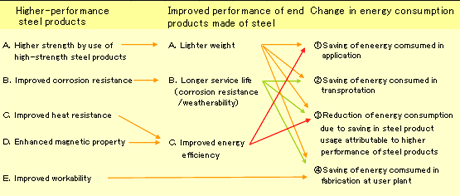
Target steel products and the field in which energy-saving effects are demonstrated by their use and the type of energy saved are as shown in table 1.

The prerequisites for estimating energy savings were individually determined for six steel products. We will describe these conditions using as our example automotive high-strength steel sheet, a product with outstanding energy-saving characteristics.
A passenger car weighing 1.1 tons was assumed for purposes of calculation.
The results of trial calculations reveal that a 10% reduction in weight produced a 4.5% improvement in fuel efficiency. This was based on the correlation between the ratio at which high-strength steel sheets were used and the rate at which vehicle weight had been reduced from 1990 to 2000.
(Production of high-strength steel sheets in FY2000 amounted to 630,000 tons, and passenger car production to 8.36 million cars.)
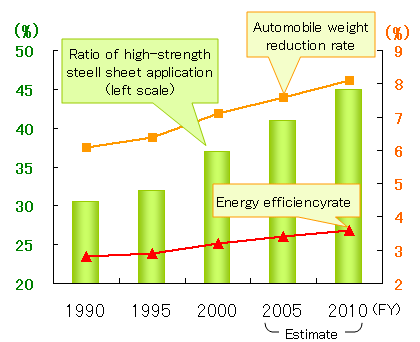
Assuming that the service life of a passenger car is ten years, trial calculations show that the energy savings accruing to a car manufactured in 2000, for instance, will amount to 89.5 PJ by the time it is scrapped at the end of its service life. (See portion hemmed by L-shaped red frame in the figure below.)
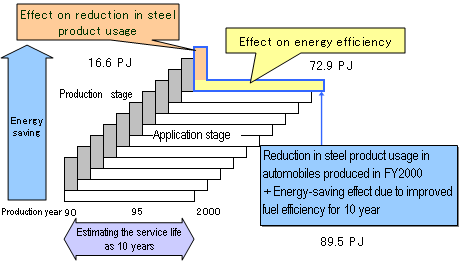
Energy Savings and Other Effects of Higher-performance Steel Products from an LCA Perspective
Table 2 summarizes the energy savings and CO2 emissions-reducing effects demonstrated over the service life of end products made with the six types of steel products covered by the present follow-up survey.
Higher-performance steel products (3.76 million tons) produced in 2000 are expected to show estimated energy savings of 238 PJ and an estimated reduction of over 15 million tons in CO2 emissions.

Furthermore, estimates were made of the reduction in CO2 emissions at certain points of time as demonstrated during their service period by end products manufactured in different years after 1990. The figure below shows the image obtained with 2000 as the typical year.
The reduction in CO2 emissions demonstrated by motor vehicles was an estimated 5.09 million tons in the typical year of 2000.
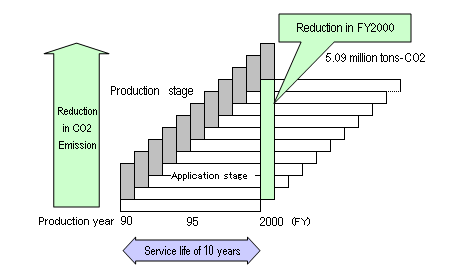
The reduction in CO2 emissions for the five remaining steel products, excluding wide-flange shapes for building construction, produced during and after 1990 totaled 6.50 million tons in the typical year of 2000.
Higher-performance steel products developed by the steel industry have shown great energy savings in their applications. This has far more than offset the increase in energy required during manufacture and has thereby contributed to a reduction in CO2 emissions in the industrial, transportation, offices and household sectors.
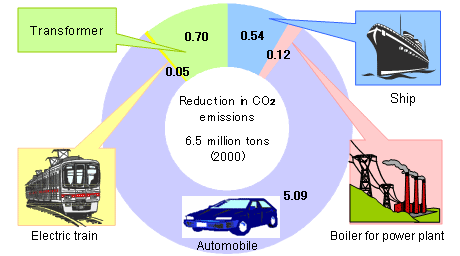
* Five products: Automotive high-strength steel sheets, high-strength shipbuilding plates, high-strength stainless steel sheets, grain-oriented electrical steel sheets for transformers, heat-resistant steel tubes for boilers